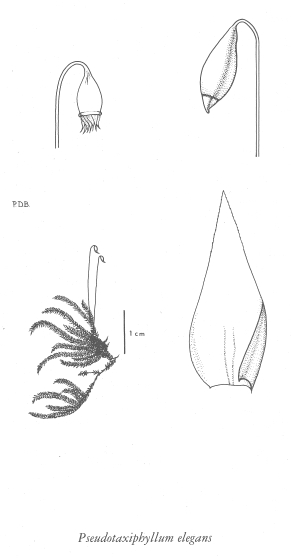Pseudotaxiphyllum elegans (Brid.) Iwats.
small flat-moss (elegant pseudotaxiphyllum moss)
Hypnaceae
Species Account Author: Wilf Schofield
Extracted from Some Common Mosses of BC
Introduction to the Bryophytes of BC
small flat-moss (elegant pseudotaxiphyllum moss)
Hypnaceae
Species Account Author: Wilf Schofield
Extracted from Some Common Mosses of BC
Introduction to the Bryophytes of BC
Map
Distribution of Pseudotaxiphyllum elegans
Click here to view the full interactive map and legend
Species Information
Species description:
Genus name indicating that the genus resembles the genus Taxiphyllum, a name meaning that the leaves appear to be in two rows because the plants are somewhat flattened. Species name reflecting the elegance of the species, perhaps indicating the original author's (Bridel) affection for the species.
Comments:
This moss has suffered from many name changes that are related to an improved understanding of its relationship to similar mosses. It has been called Plagiothecium elegans, Isopterygium elegans and I. borrerianum, all of which are synony
Distinguishing characteristics:
The somewhat flattened, pale green plants with many leaves diverging at right angles to the stem, the usually terrestrial habitat, coupled with the decidedly nodding sporangia and the masses of tiny attenuate reproductive gemmae, usually separate this species.
Habit:
Creeping, shiny, pale green to yellow-green, usually irregularly branched, somewhat flattened plants with many leaves diverging at right angles from the reclining stem and branches when the plants are moist; there is little change in appearance when the plants dry except that the leaves tend to curve downward at the points.
Similar Species:
See notes under Hypnum circinale. From species of Plagiothecium, Pseudotaxiphyllum elegans is distinguished by the narrower, more sharply pointed leaves, the gemma branches and the nodding sporangium. The leaves of Pseudotaxiphyllum often point downward toward the substratum when dry, a feature absent in Plagiothecium.
Illustration

If more than one illustration is available for a species (e.g., separate illustrations were provided for two subspecies) then links to the separate images will be provided below. Note that individual subspecies or varietal illustrations are not always available.
Illustration Source: Some Common Mosses of BC
Habitat and Range
Habitat
In usually somewhat shaded sites on earth of banks in forests, humus, rotten logs, rock and up bases of tree trunks from sea level to sub alpine forest and rarely at alpine elevationsRange
World DistributionWestern Asia to eastern Europe, also in North Africa; in eastern North America from southern Labrador to northern Georgia westward to the Great Lakes, Missouri and Arkansas; in the west, from southeastern Alaska to central California, most frequent near the coast but also found in eastern British Columbia
Status Information
Synonyms
Synonyms and Alternate Names:
Isopterygium borrerianum (Müll. Hal.) Lindb.
Isopterygium borrerianum var. gracilens (Austin ex Grout) H.A. Crum, Steere & L.E. Anderson
Isopterygium borrerianum var. terrestre (Lindb.) H.A. Crum, Steere & L.E. Anderson
Isopterygium elegans (Brid.) Lindb.
Isopterygium elegans var. gracilens Austin ex Grout
Isopterygium elegans var. schimperi (Jur. & Milde) Limpr.
Isopterygium elegans var. terrestre (Lindb.) Wijk. & Margad.
Plagiothecium elegans (Brid.) Sull.
Plagiothecium elegans var. gracilens Austin ex Grout